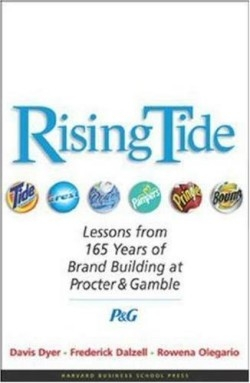
Rising Tide
Lessons from 165 Years of Brand Building at Procter & Gamble
Ads proclaiming Ivory Soap to be “ninety-nine and 44/100 percent pure” are cultural icons that go back over a hundred years. Crisco, Tide, Duncan Hines-these Procter & Gamble products are so familiar as to be an integral part of Americana. This book chronicles the growth of P&G from a small, two-family partnership established in 1837 to the international consumer goods conglomerate it is today.
Authors Dyer and Dalzell are associates of The Winthrop Group, a consulting firm dedicated to codifying corporate memory. Together and separately, they have produced several books on the history of industry in America. Olegario is an assistant professor of history at Vanderbilt University. Commissioned by P&G and provided unprecedented access to company archives, this accomplished trio compiled a comprehensive narrative detailing the corporation’s contributions to the fields of marketing, employee relations, business process reengineering, and supply chain management.
Part I, “Foundations,” covers 1837-1945. It all began when two brothers-in-law combined their candle- and soap-making operations in Cincinnati, Ohio. As railroads began linking American cities, the partners took advantage of these new land routes to expand their reach from regional to national. The next generation of Procters and Gambles experimented with business processes, early employee profit sharing plans, new technologies, and differentiated branding. In the late nineteenth century, manufacturers had no direct contact with the end user of their products. Marketer Harley Procter was the first to use advertising to communicate with consumers directly. Enduring war, economic downturns, and a major fire, P&G ended the period as a publicly held corporation with operations across the country.
The section called “Related Diversification” spans the period from post-World War II to 1980. During these years, the corporation focused on innovation, branding, and vertical and horizontal diversification through acquisition. The introduction of Tide, a laundry detergent based on synthetic compounds rather than soap chemicals, most impacted company fortunes.
“The Era of Heightened Competition and Globalization” covers the years from 1980 to the present. Fighting intense competition from Colgate, Unilever, and Kimberley-Clark, P&G pursued international markets. In a daring move, P&G partnered with retailing giant Wal-Mart to experiment with computerized supply chain management. The results of this project showed that collaboration between suppliers and retailers benefited both parties and their customers.
The story of one company’s creative responses to environmental, competitive, and historical pressures, Rising Tide is an informative catalogue of corporate accomplishments aimed at a largely academic audience. It’s also chock full of P&G lore, making it a quick and enjoyable read for employees, stockholders, and the mildly curious.
Reviewed by
Joyce Faulkner
Disclosure: This article is not an endorsement, but a review. The publisher of this book provided free copies of the book to have their book reviewed by a professional reviewer. No fee was paid by the publisher for this review. Foreword Reviews only recommends books that we love. Foreword Magazine, Inc. is disclosing this in accordance with the Federal Trade Commission’s 16 CFR, Part 255.
